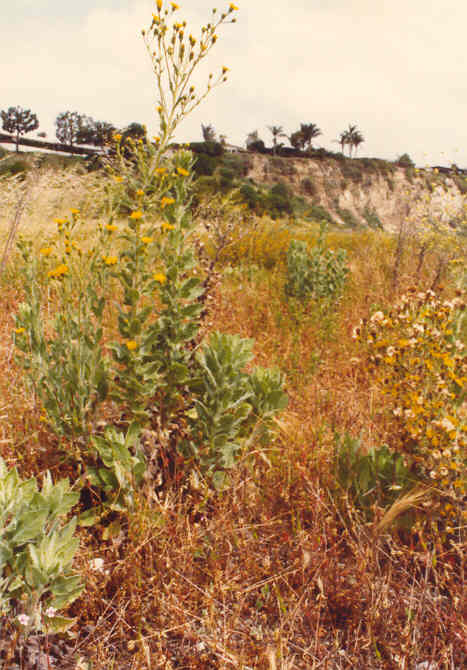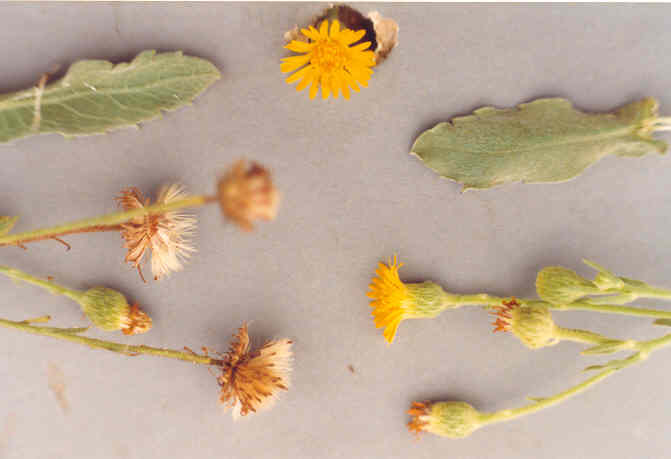
Heterotheca grandiflora Nutt.
Asteraceae (Sunflower Family)
Native
Telegraph Weed
 |
Heterotheca grandiflora Nutt.Asteraceae (Sunflower Family)Native
Telegraph Weed
|
April Photo
Plant Characteristics: Annual
or biennial, the stout stem simple below, 5-20 dm. tall, hirsute, the ample
infl. glandular-pubescent and heavy scented; lvs. thickish, densely villous,
ovate to oblanceolate, 2-7 cm. long, obtuse, serrate, the lower petioled, the
upper narrowed to a sessile base; invol. 7-9 mm. high; ray-fls. 25-35, the
corolla 6-8 mm. long, 1 mm. wide, revolute from the tip, with hairy tube;
disk-fls. 50-65, slender; pappus brick red, the outer series
inconspicuous.
Habitat: Sandy open
coastal valleys below 3000 ft., behaving as a weed; Coastal Sage Scrub,
Chaparral, S. Oak Wd.; cismontane s. Calif. to cent. Calif.
Jan.-Dec.
Name: Greek, heteros, different, and theke,
case or ovary, from the unlike aks. of ray and disk. (Munz, Flora So. Calif.
187). Grandiflora, refers to the blossoms. The common name
was probably given because of the tall, straight stems, like a telegraph pole.
There is also a strong creosote smell about the plant that is reminiscent
of telegraph poles. (Dale 68).
General: Very common
in the study area. Photographed on
North Star Beach and 23rd Street. (my comments).
Telegraph Weed blooms the year round especially along roads and in waste
places. When you see the less than spectacular blossom, you may wonder why grandiflora
was chosen as a species name. When
asked about this, a learned botanist once replied, "You should see the
other one." There is only one
other in California, Camphor Weed, (H.
subaxillaris) and the flowers are smaller.
(Dale 68). The
1993 Jepson manual lists four other species in this genus as occurring in
California. (my comment). The
Luiseno Indians made arrow foreshafts from this plant.
(Heizer and Elsasser 247).
A tea of the plant or the diluted tincture is antiseptic and antifungal
and may be used whenever there is a need for a cleansing wash prior to bandaging
or dressing a moderate abrasion, scrape, or cut.
More especially, the tincture or salve is a first-rate liniment or
ointment for any sprains, dislocations, or hyperextensions.
It doesn't work quite as well for treating arthritis as true Arnica, but
it works nonetheless. (Moore, Medicinal
Plants of the Desert and Canyon West 22).
Three or more spp. in s. U.S. and Mex. (Munz, Flora So. Calif. 187).
Text Ref: Hickman, Ed.
286; Munz, Calif. Flora 1171; Munz, Flora
So. Calif. 188; Roberts 12.
Photo Ref: Dec 3 82 #
19; April 7 83 # 5; Aug 1 84 # 5; Aug 1 86 # 19.
Identity: by R. De Ruff.
Computer Ref: Plant Data 183.
Have plant specimen.
Last edit 10/20/02.
 |